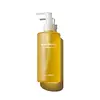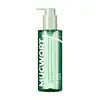What's inside
What's inside
 Key Ingredients
Key Ingredients

 Benefits
Benefits

 Concerns
Concerns

 Ingredients Side-by-side
Ingredients Side-by-side

Glycine Soja Oil 50%
EmollientSorbeth-30 Tetraoleate
EmulsifyingCetyl Ethylhexanoate
EmollientEthylhexyl Palmitate
EmollientParfum
MaskingEthylhexylglycerin
Skin ConditioningWater
Skin ConditioningGlycerin
HumectantBifida Ferment Lysate
Skin Conditioning1,2-Hexanediol
Skin ConditioningSimmondsia Chinensis Seed Oil
EmollientOryza Sativa Bran Oil
EmollientCaprylic/Capric Triglyceride
MaskingCamellia Sinensis Seed Oil
HumectantButylene Glycol
HumectantHoney Extract
HumectantRoyal Jelly Extract
Skin ConditioningPropolis Extract
Skin ConditioningGlycine Soja Oil 50%, Sorbeth-30 Tetraoleate, Cetyl Ethylhexanoate, Ethylhexyl Palmitate, Parfum, Ethylhexylglycerin, Water, Glycerin, Bifida Ferment Lysate, 1,2-Hexanediol, Simmondsia Chinensis Seed Oil, Oryza Sativa Bran Oil, Caprylic/Capric Triglyceride, Camellia Sinensis Seed Oil, Butylene Glycol, Honey Extract, Royal Jelly Extract, Propolis Extract
Ethylhexyl Palmitate
EmollientCetyl Ethylhexanoate
EmollientSorbeth-30 Tetraoleate
EmulsifyingSorbitan Sesquioleate
EmulsifyingEthylhexylglycerin
Skin ConditioningSimmondsia Chinensis Seed Oil
EmollientCannabis Sativa Seed Oil
EmollientNageia Nagi Seed Oil
AntiseborrhoeicVitis Vinifera Seed Oil
EmollientSesamum Indicum Seed Oil
EmollientPrunus Amygdalus Dulcis Oil
Skin ConditioningThymus Zygis Flower Oil
MaskingUlmus Davidiana Root Extract
Skin ConditioningSqualane
EmollientMelaleuca Alternifolia Leaf Extract
PerfumingRosa Indica Flower Extract
AntioxidantWater
Skin ConditioningActinidia Chinensis Fruit Extract
EmollientPhormium Tenax Leaf Water
AntioxidantButylene Glycol
HumectantChamomilla Vulgaris Extract
Skin ProtectingOcimum Basilicum Leaf Extract
Skin ConditioningGlyceryl Glucoside
HumectantCarum Carvi Seed Oil
MaskingLac Powder
Skin ConditioningVateria Indica Bark Extract
AntioxidantSolanum Melongena Fruit Extract
Skin ConditioningMelaleuca Alternifolia Leaf Oil
AntioxidantCallitris Columellaris Leaf/Wood Extract
AntioxidantGlycerin
Humectant1,2-Hexanediol
Skin ConditioningTriticum Vulgare Germ Extract
Skin ConditioningCentella Asiatica Extract
CleansingEthylhexyl Palmitate, Cetyl Ethylhexanoate, Sorbeth-30 Tetraoleate, Sorbitan Sesquioleate, Ethylhexylglycerin, Simmondsia Chinensis Seed Oil, Cannabis Sativa Seed Oil, Nageia Nagi Seed Oil, Vitis Vinifera Seed Oil, Sesamum Indicum Seed Oil, Prunus Amygdalus Dulcis Oil, Thymus Zygis Flower Oil, Ulmus Davidiana Root Extract, Squalane, Melaleuca Alternifolia Leaf Extract, Rosa Indica Flower Extract, Water, Actinidia Chinensis Fruit Extract, Phormium Tenax Leaf Water, Butylene Glycol, Chamomilla Vulgaris Extract, Ocimum Basilicum Leaf Extract, Glyceryl Glucoside, Carum Carvi Seed Oil, Lac Powder, Vateria Indica Bark Extract, Solanum Melongena Fruit Extract, Melaleuca Alternifolia Leaf Oil, Callitris Columellaris Leaf/Wood Extract, Glycerin, 1,2-Hexanediol, Triticum Vulgare Germ Extract, Centella Asiatica Extract
Ingredients Explained
These ingredients are found in both products.
Ingredients higher up in an ingredient list are typically present in a larger amount.
1,2-Hexanediol is a synthetic liquid and another multi-functional powerhouse.
It is a:
- Humectant, drawing moisture into the skin
- Emollient, helping to soften skin
- Solvent, dispersing and stabilizing formulas
- Preservative booster, enhancing the antimicrobial activity of other preservatives
Butylene Glycol (or BG) is used within cosmetic products for a few different reasons:
Overall, Butylene Glycol is a safe and well-rounded ingredient that works well with other ingredients.
Though this ingredient works well with most skin types, some people with sensitive skin may experience a reaction such as allergic rashes, closed comedones, or itchiness.
Learn more about Butylene GlycolCetyl Ethylhexanoate is an emollient ester. It comes from cetearyl alcohol and 2-ethylhexanoic acid.
Cetyl Ethylhexanoate is an emollient that adds a velvety feel to skin without being greasy or oily. Emollients help trap moisture into your skin, keeping your skin soft and hydrated.
Ethylhexyl Palmitate, also known as octyl palmitate, is created from 2-ethylhexyl alcohol and palmitic acid. It is a fatty acid ester.
The fatty acid content of Ethylhexyl Palmitate makes it an emollient. Emollients help soften and hydrate your skin by trapping moisture within.
Ethylhexyl Palmitate is also used to help improve the texture of cosmetics. It helps other ingredient dissolve in products and help disperse ingredients more evenly.
You'll likely find this ingredient in sunscreen, as it is often used to mix UV-blocking ingredients such as avobenzone and ethylhexyl triazone.
It can also help stabilize the fragrances in a product as a fragrance fixative.
Ethylhexyl Palmitate can be used to substitute mineral oil.
Due to its high fatty acid content, it may not be fungal-acne safe.
Learn more about Ethylhexyl PalmitateEthylhexylglycerin (we can't pronounce this either) is commonly used as a preservative and skin softener. It is derived from glyceryl.
You might see Ethylhexylglycerin often paired with other preservatives such as phenoxyethanol. Ethylhexylglycerin has been found to increase the effectiveness of these other preservatives.
Glycerin is already naturally found in your skin. It helps moisturize and protect your skin.
A study from 2016 found glycerin to be more effective as a humectant than AHAs and hyaluronic acid.
As a humectant, it helps the skin stay hydrated by pulling moisture to your skin. The low molecular weight of glycerin allows it to pull moisture into the deeper layers of your skin.
Hydrated skin improves your skin barrier; Your skin barrier helps protect against irritants and bacteria.
Glycerin has also been found to have antimicrobial and antiviral properties. Due to these properties, glycerin is often used in wound and burn treatments.
In cosmetics, glycerin is usually derived from plants such as soybean or palm. However, it can also be sourced from animals, such as tallow or animal fat.
This ingredient is organic, colorless, odorless, and non-toxic.
Glycerin is the name for this ingredient in American English. British English uses Glycerol/Glycerine.
Learn more about GlycerinThis oil comes from the seeds of the desert shrub called Jojoba. It is more commonly known as jojoba oil, a non-comedogenic oil.
Jojoba oil does not contain fragrance and has many fatty-acids, making it a great soothing ingredient.
It also contains Vitamin E, a great moisturizing ingredient. Vitamin E is also an antioxidant and protects your skin against oxidative damage.
This ingredient humectant properties, meaning it helps draw moisture from the air. This helps keep your skin hydrated.
While jojoba has antibacterial properties, it is only able to kill some strains of bacteria.
Studies also show it helps in wound healing. In fact, Indigenous cultures have used jojoba as a moisturizer and to help treat burns for centuries.
Fun fact: Jojoba oil similar to natural human skin sebum, so it has a great effect on dry skin. It is also promising with helping to regulate sebum production.
Due to its fatty acid content, Jojoba oil may not be fungal acne safe. We recommend speaking with a professional if you have any concerns.
Learn more about Simmondsia Chinensis Seed OilSorbeth-30 Tetraoleate is a surfactant and emulsifier.
This ingredient is a tetraester from oleic acid and polyethylene glycol ether of sorbitol.
As an emulsifier, it helps ingredients such as oil and water mix together. This allows the dirt and oils in your skin to be washed away.
One study found pumpkin oil containing Sorbeth-30 Tetraoleate helped hydrate the skin and did not cause any irritation.
Learn more about Sorbeth-30 TetraoleateWater. It's the most common cosmetic ingredient of all. You'll usually see it at the top of ingredient lists, meaning that it makes up the largest part of the product.
So why is it so popular? Water most often acts as a solvent - this means that it helps dissolve other ingredients into the formulation.
You'll also recognize water as that liquid we all need to stay alive. If you see this, drink a glass of water. Stay hydrated!
Learn more about Water